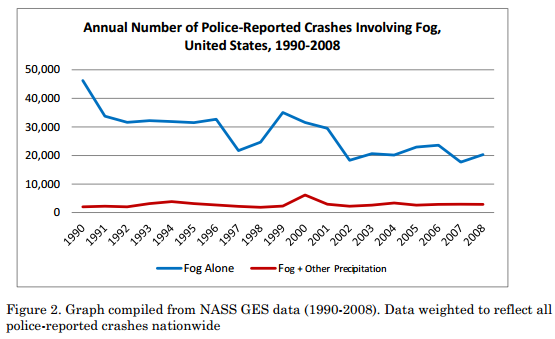AAA FOUNDATION FOR TRAFFIC SAFETY
Introduction
For three pre-dawn hours of January 29, 2012, the Florida Highway Patrol closed and monitored a stretch of Interstate 75 near Gainesville, Florida, due to thick smoke and fog that had contributed to a non-fatal three-car crash. As visibility improved, the roadway was reopened, despite at least one Trooper’s insistence that conditions could change rapidly and smoke and fog could return without warning. Less than an hour later, 11 people were killed and 18 were injured in a 19-vehicle pileup attributed to a sudden drop in visibility when smoke and fog again covered the freeway.
Fog presents numerous challenges to motorists. By definition, it reduces visibility to less than 5/8-mile, and, as fog obscures details of the driving environment and reduces contrast, drivers have difficulty accurately perceiving certain things that are crucial for safe driving, such as depth and speed. Moreover, because high beams reflect off of the suspended water droplets that fog comprises and actually make it harder to see, drivers are deprived of a tool that is useful in other low-visibility situations. And, as was seen in the Florida crash, fog can blanket a roadway with little warning and create sudden and dramatic changes in driving conditions.
Despite these dangers, research addressing the issue of fog and its impact on highway safety is relatively sparse, though some illuminating studies do exist. In examining driver behavior in fog, Broughton et al. determined that fog divides motorists into two camps, which they called “laggers” and “non-laggers.” Non-laggers (the predominant group) – perhaps feeling uncomfortable with the loss of visual reference points in the fog – try to stay within eyeshot of the vehicles in front of them, even though doing so often requires following at an unsafe distance. To make matters worse, motorists might not be aware of how dangerous their chosen following distance is: Cavallo et al. found that their study participants perceived a lead car to be 60 percent farther away in foggy conditions than in clear conditions. The potential for crashes when drivers simultaneously try to maintain visual contact with lead vehicles and fail to realize how close they have to come to do so is evident.
Safe following distances are, of course, related to travel speeds, and here too the existing research highlights some issues. Brooks et al., for example, found that drivers do not tend to reduce speed in fog until their ability to stay in their travel lane is compromised.
Because lane markings (which are close to the vehicle and often retroreflective) may remain detectable even in certain limited-visibility conditions, Brooks et al. cautioned that drivers can become overconfident in fog, and also found that when motorists do finally slow down, the speed reduction is often not sufficient to avoid unexpected hazards. Furthermore, Mueller et al. looked at this issue through the lens of driver experience, and found that young novice drivers were the slowest to react to hazards, and reduced their speed the least in response to foggy conditions.
While these and other studies provide insight into driver behavior and perception of speed and distance in fog, they do not address crash outcomes or trends related to foggy conditions. Here the research is even sparser. Abdel-Aty et al., in an effort to fill this void,
took a detailed look at fog and smoke-related crashes in Florida, using crash data from 2003-2007.9 Among their findings were that fog- and smoke-related crashes were most likely to occur during the winter months (December – February), in the early morning
hours, and in rural areas. They also found that crashes in smoke and fog tended to involve more vehicles and more serious injuries than did crashes in clear visibility conditions.
This study paints a more complete picture of fog- and smoke-related fatal crashes (FSFC) and fog- and smoke-related police-reported crashes (FSPC) by examining national trends. It offers a descriptive analysis of 23 years of crash data (1990-2012) from the National Highway Traffic Safety Administration’s Fatality Analysis Reporting System (FARS), and 19 years of data (1990-2008) from the National Automotive Sampling System General Estimates System (NASS GES). Such an analysis will help fill some of the knowledge gaps regarding fog- and smoke-related crashes, and be of benefit to overall highway safety efforts given the elevated potential for severe and multi-vehicle crashes in foggy conditions.
Download full version (PDF): Hidden Highways
About the AAA Foundation for Traffic Safety
www.aaafoundation.org
The AAA Foundation for Traffic Safety was founded in 1947 by AAA to conduct research to address growing highway safety issues. The organization’s mission is to identify traffic safety problems, foster research that seeks solutions and disseminate information and educational materials.
Tags: AAA, AAA Foundation for Traffic Safety, FL, Florida, safety







 RSS Feed
RSS Feed